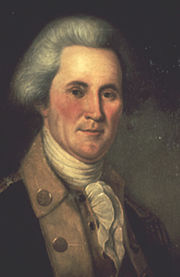| Washington District/County Regiment | |
|---|---|
 Colonel John Sevier | |
| Active | 1776-1777 Washington District regiment, 1777-1783 Washington County regiment |
| Country | United States |
| Allegiance |
|
| Branch | North Carolina militia |
| Type | Militia |
| Part of | Salisbury District Brigade, Morgan District Brigade |
| Engagements | Siege of Fort Caswell, Cherokee Expedition, Battle of Brier Creek, Battle of Guilford Court House, Battle of Monck's Corner, Battle of Camden, Battle of Musgrove Mill, Battle of Kings Mountain, Battle of Cowpens, Battle of Eutaw Springs |
| Commanders | |
| Notable commanders |
Col. John Carter Col. Evan Shelby, Sr. Col. John Sevier[1] |
The Washington District Regiment was authorized on December 23, 1776 by the Province of North Carolina Congress. It was subordinate to the Salisbury District Brigade of militia. The regiment was renamed the Washington County Regiment. The regiment was engaged in battles and skirmishes against the British and Cherokee during the American Revolution in Virginia, North Carolina, South Carolina, Tennessee, and Georgia between 1776 and 1782. It was active until the end of the war.[1][2][3]
History[]
The Washington District Regiment was established on December 23, 1776 by the North Carolina Provincial Congress. Washington District became Washington County, North Carolina in 1777. The regiment was rename the Washington County Regiment on December 18, 1777. The Washington District Regiment was part of the Salisbury District Brigade when it was created in 1776. It was transferred to the newly created Morgan District Brigade when it was created in 1782.
Note: After the war, Washington County, North Carolina became part of the Southwest Territory in 1790. In 1779, Sullivan County was created by North Carolina from part of Washington County. In 1783, Green County was created by North Carolina out of Washington County. When Tennessee was admitted to the United States in 1796, Washington County became Washington County, Tennessee. This county should not be confused with a separate location, Washington County, North Carolina created in 1799 from Tyrrell County.[4][5] Colonels of the Regiment included the following:[1]
- Colonel John Carter, commandant (1776–1781)[6]
- Colonel Evan Shelby, Sr., second colonel (1776–1783)[7]
- Colonel John Sevier, commandant (1781–1783), Lieutenant Colonel (1776–1781)[8]
See Engagements of the Salisbury District Brigade Regiments for a list of engagements of this regiment.
See also[]
- List of American Revolutionary War battles
- Southern Campaigns: Pension Transactions for a description of the transcription effort by Will Graves
- Southern theater of the American Revolutionary War
- Washington District, North Carolina, Washington County, Tennessee
References[]
- ↑ 1.0 1.1 1.2 Lewis, J.D.. "Washington District/County Regiment". http://www.carolana.com/NC/Revolution/nc_washington_county_regiment.html. Retrieved March 4, 2019.
- ↑ Arthur, John Preston (1914). Western North Carolina; a history (1730-1913). National Society Daughters of the American Revolution of North Carolina. Edward Buncombe Chapter, Asheville, North Carolina. https://archive.org/details/westernnorthcaro00arth/page/n8. Retrieved Jan 29, 2019.
- ↑ Hunter, C.L. (1877). Sketches of western North Carolina, historical and biographical : illustrating principally the Revolutionary period of Mecklenburg, Rowan, Lincoln, and adjoining counties, accompanied with miscellaneous information, much of it never before published. Raleigh: Raleigh News Steam Job Print. pp. 166–183. https://archive.org/details/sketcheswestern00huntgoog.
- ↑ John Finger, Tennessee Frontiers: Three Regions in Transition (Bloomington, Ind.: Indiana University Press, 2001), pp. 46–47.
- ↑ Cockrell, David L. (2006). "Watauga Settlement". https://www.ncpedia.org/watauga-settlement. Retrieved September 12, 2019.
- ↑ Herndon, G. Melvin (1979). "John Carter". https://www.ncpedia.org/biography/carter-john. Retrieved September 12, 2019.
- ↑ Beasley, Paul W. (1994). "Evan Shelby". https://www.ncpedia.org/biography/shelby-evan. Retrieved September 12, 2019.
- ↑ Corlew, Robert E. (1994). "John Sevier". https://www.ncpedia.org/biography/sevier-john. Retrieved September 12, 2019.
The original article can be found at Washington District Regiment and the edit history here.